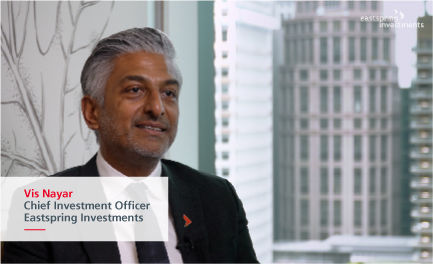The world faces a year of uncertainty going into 2025. Global growth is expected to plod along in the first half of 2025, with the second half influenced by developments in the US and China. The incoming Trump administration’s policies are expected to be inflationary and boost US short-term growth, but protectionism and tariffs may weigh on the global economy. China’s further stimulus measures will be closely watched. The US Fed’s rate cut cycle may be tempered by a cloudier inflation picture with the Fed’s terminal rate potentially higher than initially expected.
Market volatility presents active opportunities for equity investors while carry is likely to drive bond returns. Market disappointments over rising inflation, the uncertain path of US interest rates, and the risk of a stronger US dollar can impact asset prices in 2025. Given this economic backdrop, investors will need to be smarter about how they diversify and manage risks.
Download 2025 Market OutlookInvestment ideas
Our investment teams have identified these opportunities for 2025
Embracing Asia’s giants
Fig: Japan’s return on equity has improved
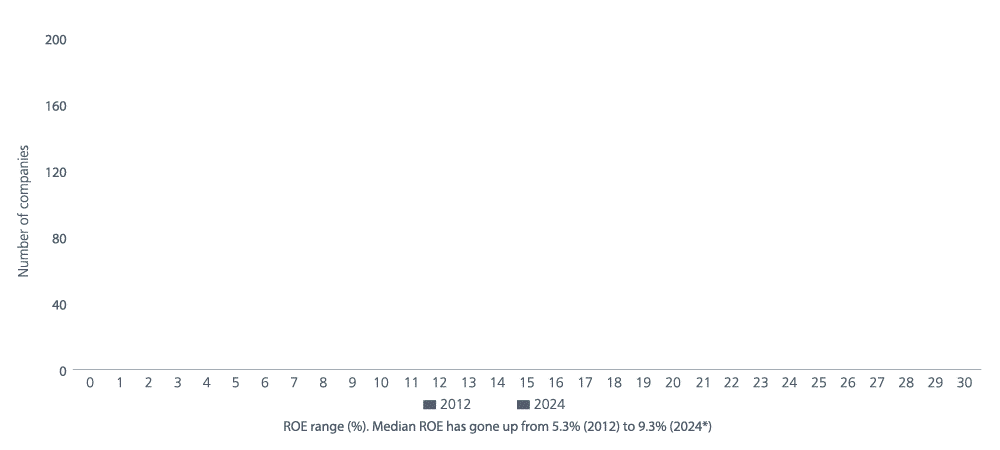
- China, India and Japan’s unique opportunity set merits standalone allocation in investor portfolios.
- Japan's equity market rally may broaden out in 2025 with greater opportunities for mid-to-small cap stocks. These are more closely tied to the domestic economy and can benefit from rising wages and increased consumer spending. Japan 's push towards improving corporate governance is improving return on equity and should support share prices.
- China's near-term uncertainties call for caution, but equity valuations are relatively cheap, and the government may implement additional stimulus measures. Picking the right entry points and selecting stocks with visible earnings growth drivers is key.
- Active management will be important for India's equity market in 2025. Large-cap companies appear more attractively priced. Ongoing reforms, rising urbanisation, and supply chain shifts can support India's longer-term economic and earnings growth.
Source: Eastspring Investments (Singapore), BofA Global Research, QUICK as at 30 June 2024. *Based on QUICK consensus (current fiscal year) for 2024. “ROE”: return of equity
Download 2025 Market OutlookFocusing on value
Fig: EMs offer an excellent entry point at current value
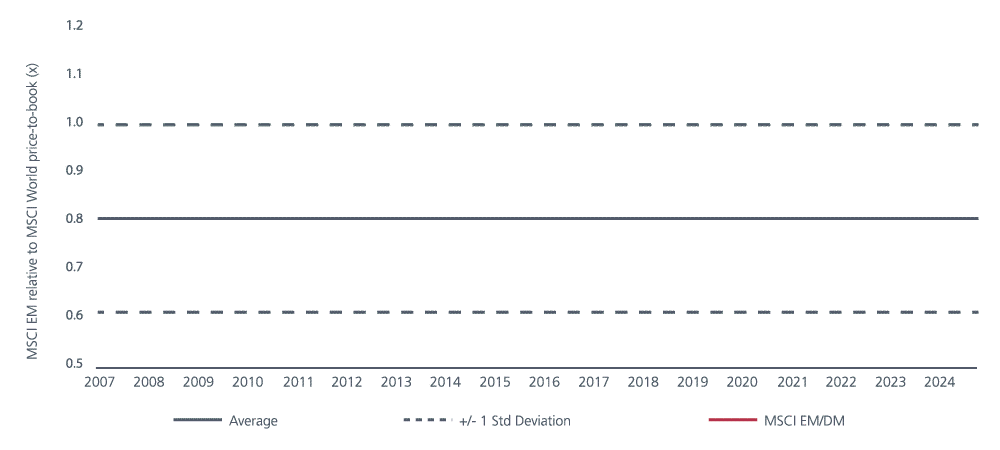
- Aggressive US domestic stimulus and trade protectionist policies by the incoming US government may lead to higher inflation and a stronger USD. This will have an impact on Asian and Emerging Markets (EMs).
- However, EMs’ long-term growth drivers like increased capital expenditure, infrastructure investment and supply chain diversification remain strong and are leading to higher earnings.
- Despite recent difficulties, Latin America and Emerging Europe present investment opportunities and upside potential while Asia Pacific ex Japan remains attractively valued, though some sectors may be affected by higher US tariffs.
- ASEAN markets are less vulnerable than North Asian markets, thanks to their lower dependence on US revenue and fewer direct US competitors.
- Disciplined stock picking is key, with interesting opportunities in Hong Kong, Indonesia and Thailand.
Source: Datastream Refinitiv, MSCI Emerging Markets (EM) and MSCI World (DM) as of 31 October 2024
Download 2025 Market OutlookBeing tactical and nimble
Fig: US Treasury yields have risen significantly
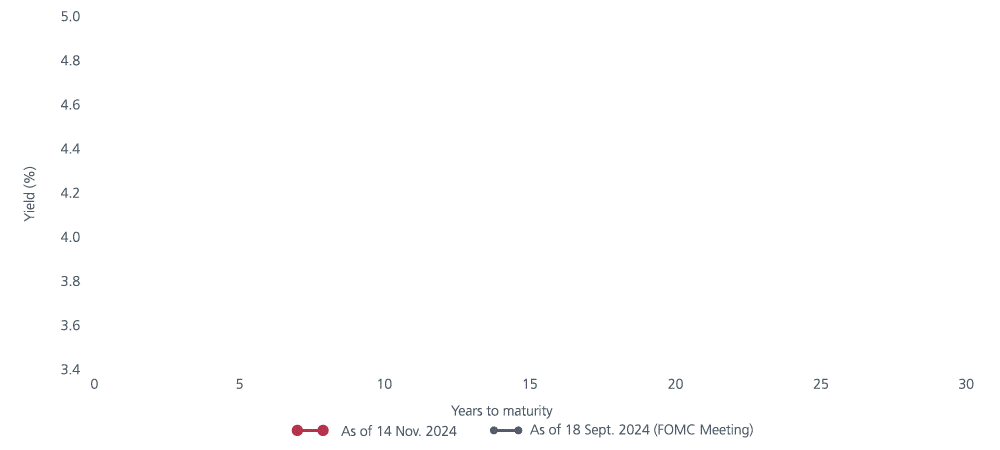
- In 2024, bonds have generally benefited from the end of aggressive monetary tightening, rate cut prospects, and stable inflation.
- US Treasury yields have risen off the lows in September; strong US economic data followed by the US election outcome have markets anticipating higher inflation into 2025.
- Continued robust US data might also prompt the Fed to adjust its policy, supporting front-end yields and a stronger USD.
- Rising yields have made USD-denominated credits and USD duration more attractive. However, as USD duration presents volatility risks arising from the uncertain fiscal outlook, long duration views may be better expressed in Asian and EM currencies.
- Asian currency bonds (fully hedged back to USD) can also deliver an attractive boost to overall portfolio yields via meaningful carry advantage. Higher credit quality is preferred as credit spreads are at historical tights.
Source: LSEG Datastream of US Treasuries bond (bid) yields as of 14 November 2024
Download 2025 Market OutlookSeizing thematic trends
Fig: Actively managed climate transition funds are not yet mainstream
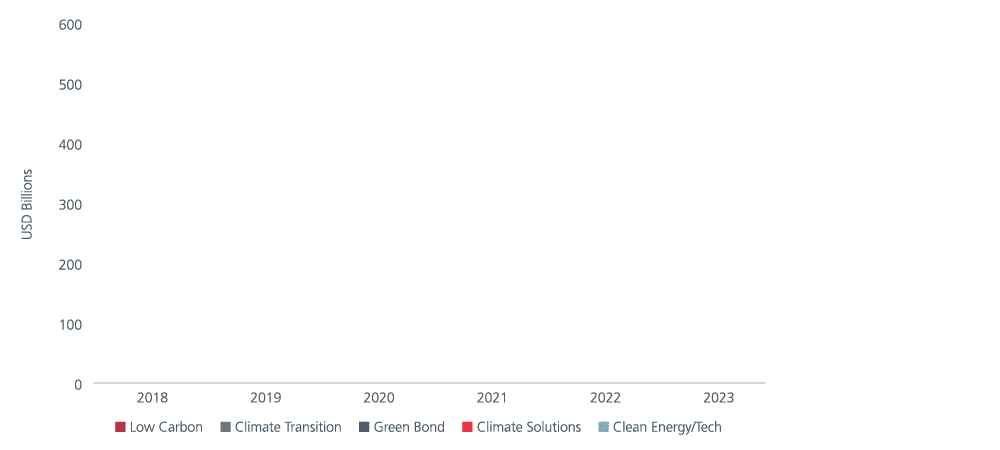
- Assets under management for climate transition funds have grown rapidly but the narrow definitions of transition risks/opportunities in many climate transition funds suggest that there is upside potential for investors.
- A holistic approach that includes the brown-to-green transition over the net zero pathway significantly broadens the investable universe.
- By identifying potentially mispriced companies that are in the early stages of their climate transition journey, a holistic approach can offer more alpha opportunities, enabling sustainable investing without sacrificing returns.
Source: Eastspring Investment (Singapore) Limited. Graph from Morningstar (2024) Investing in times of climate change 2023 in Review. Text adapted by Eastspring from Morningstar (2024). PAB - Paris-aligned Benchmark. CTB - Climate Transition Benchmark.
Download 2025 Market OutlookEnhancing portfolio buffers
Fig: Low volatility strategies work exceptionally well in most market environments
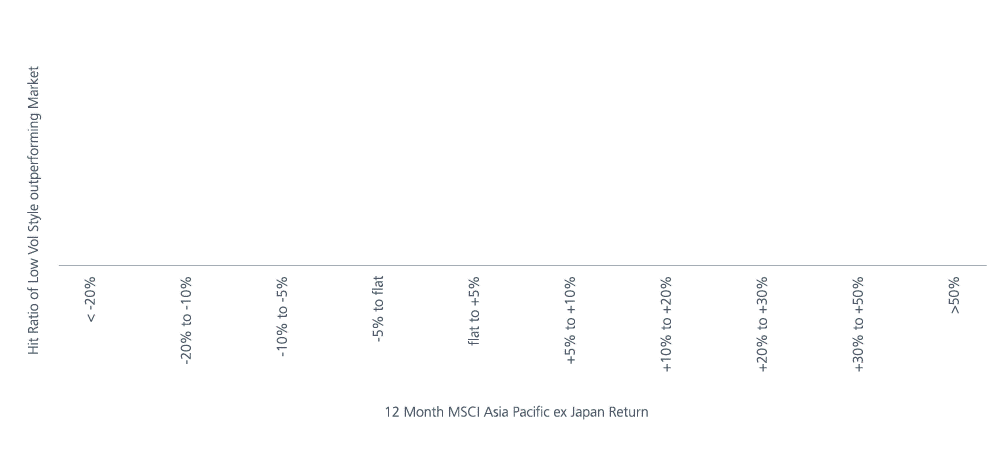
- Diversified alpha streams with varying time horizons have become more crucial following the policy lags and disruptions arising from COVID-19.
- Combining human judgment with rigorous data-driven processes and fortifying stress testing frameworks should help to better navigate rapid market drawdowns.
- Despite volatile stock-bond correlations, multi asset portfolios remain relevant, requiring agility and tactical adjustments as conditions evolve.
- Adding dividend income streams in multi asset portfolios can buffer market drawdowns especially in Asia where Asian companies have the capacity to boost dividends and consistently prioritise shareholder returns throughout economic cycles.
- Similarly low volatility equity strategies can help cushion against downside risks and contribute to more stable returns in 2025; historical data supports this view.
Source: Eastspring Investments, Bloomberg. All rolling 12-month returns from May 2001 to August 2024.
Download 2025 Market OutlookInvestment ideas
Our investment teams have identified the opportunities for 2025
Embracing Asia’s giants
Fig: Japan’s return on equity has improved

- China, India and Japan’s unique opportunity set merits standalone allocation in investor portfolios.
- Japan's equity market rally may broaden out in 2025 with greater opportunities for mid-to-small cap stocks. These are more closely tied to the domestic economy and can benefit from rising wages and increased consumer spending. Japan's push towards improving corporate governance is improving return on equity and should support share prices.
- China's near-term uncertainties call for caution, but equity valuations are relatively cheap, and the government may implement additional stimulus measures. Picking the right entry points and selecting stocks with visible earnings growth drivers is key.
- Active management will be important for India's equity market in 2025. Large-cap companies appear more attractively priced. Ongoing reforms, rising urbanisation, and supply chain shifts can support India's longer-term economic and earnings growth.
Source: Eastspring Investments (Singapore), BofA Global Research, QUICK as at 30 June 2024. *Based on QUICK consensus (current fiscal year) for 2024. “ROE”: return of equity
Download 2025 Market OutlookFocusing on value
Fig: EMs offer an excellent entry point at current value

- Aggressive US domestic stimulus and trade protectionist policies by the incoming US government may lead to higher inflation and a stronger USD. This will have an impact on Asian and Emerging Markets (EMs).
- However, EMs’ long-term growth drivers like increased capital expenditure, infrastructure investment and supply chain diversification remain strong and are leading to higher earnings.
- Despite recent difficulties, Latin America and Emerging Europe present investment opportunities and upside potential while Asia Pacific ex Japan remains attractively valued, though some sectors may be affected by higher US tariffs.
- ASEAN markets are less vulnerable than North Asian markets, thanks to their lower dependence on US revenue and fewer direct US competitors.
- Disciplined stock picking is key, with interesting opportunities in Hong Kong, Indonesia and Thailand.
Source: Datastream Refinitiv, MSCI Emerging Markets (EM) and MSCI World (DM) as of 31 October 2024
Download 2025 Market OutlookBeing tactical and nimble
Fig: US Treasury yields have risen significantly

- In 2024, bonds have generally benefited from the end of aggressive monetary tightening, rate cut prospects, and stable inflation.
- US Treasury yields have risen off the lows in September; strong US economic data followed by the US election outcome have markets anticipating higher inflation into 2025.
- Continued robust US data might also prompt the Fed to adjust its policy, supporting front-end yields and a stronger USD.
- Rising yields have made USD-denominated credits and USD duration more attractive. However, as USD duration presents volatility risks arising from the uncertain fiscal outlook, long duration views may be better expressed in Asian and EM currencies.
- Asian currency bonds (fully hedged back to USD) can also deliver an attractive boost to overall portfolio yields via meaningful carry advantage. Higher credit quality is preferred as credit spreads are at historical tights.
Source: LSEG Datastream of US Treasuries bond (bid) yields as of 14 November 2024
Download 2025 Market OutlookSeizing thematic trends
Fig: Actively managed climate transition funds are not yet mainstream

- Assets under management for climate transition funds have grown rapidly but the narrow definitions of transition risks/opportunities in many climate transition funds suggest that there is upside potential for investors.
- A holistic approach that includes the brown-to-green transition over the net zero pathway significantly broadens the investable universe.
- By identifying potentially mispriced companies that are in the early stages of their climate transition journey, a holistic approach can offer more alpha opportunities, enabling sustainable investing without sacrificing returns.
Source: Eastspring Investment (Singapore) Limited. Graph from Morningstar (2024) Investing in times of climate change 2023 in Review. Text adapted by Eastspring from Morningstar (2024). PAB - Paris-aligned Benchmark. CTB - Climate Transition Benchmark.
Download 2025 Market OutlookEnhancing portfolio buffers
Fig: Low volatility strategies work exceptionally well in most market environments

- Diversified alpha streams with varying time horizons have become more crucial following the policy lags and disruptions arising from COVID-19.
- Combining human judgment with rigorous data-driven processes and fortifying stress testing frameworks should help to better navigate rapid market drawdowns.
- Despite volatile stock-bond correlations, multi asset portfolios remain relevant, requiring agility and tactical adjustments as conditions evolve.
- Adding dividend income streams in multi asset portfolios can buffer market drawdowns especially in Asia where Asian companies have the capacity to boost dividends and consistently prioritise shareholder returns throughout economic cycles.
- Similarly low volatility equity strategies can help cushion against downside risks and contribute to more stable returns in 2025; historical data supports this view.
Source: Eastspring Investments, Bloomberg. All rolling 12-month returns from May 2001 to August 2024.
Download 2025 Market OutlookViews from the region
Different perspectives from our investment teams across the region




